How to Grow Sunflowers
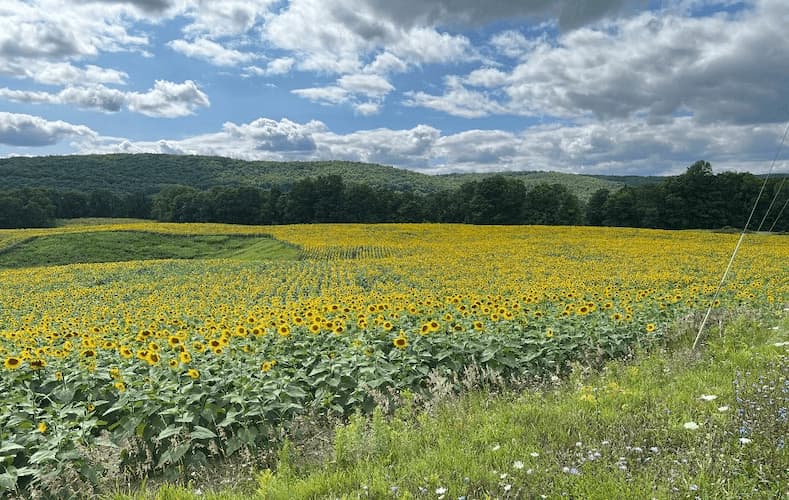
Growing Beautiful Sunflowers
Some folks see a Sunflower as a flower. Others, see it as a vegetable. It is, of course, both a beautiful flower and a great vegetable! Healthy, nutritious, and attractive, Sunflowers have it all. And as your backyard birds will tell you, sunflower seeds are delicious. That is probably why they have spread from their native home in North America and are now grown around the world. And the varieties of sunflowers are truly amazing. Some varieties grow just two feet tall, while others can grow 20 to 30 feet tall. And the range of flower colors and bi-colors produce a beautifully attractive display. So, whatever variety of sunflowers you choose to grow, you will be thrilled.
As homeowners, we adorn our yards and gardens with our choice of dozens of varieties, in a wide range of sizes and colors. We use it to attract birds to our homes. Like the birds, we also enjoy eating the seeds. They are high in protein. Sunflowers are popular as cooking oil, too.
Sunflowers are great for kids. The seeds are big and easy to handle, and they require minimal attention. Kids like to grow big things, so a giant sunflower is just perfect for a beginner gardener. The end product is not only eye appealing but makes a great snack. We put Sunflowers, along with pumpkins, as the top two plants for kids to grow.
The most popular giant sunflower plants are called “Mammoth Sunflowers”. This sunflower variety has a huge head filled with big, plump grey and black seeds.
Did You Know? Sunflowers are a symbol of hope.
Uses for Sunflowers
There are many uses for Sunflowers. They include:
- They are just beautiful to look at as flowers in your backyard.
- Sunflowers look great indoors in a vase.
- They are popular for fall decorating.
- There’s are many recipes that include them.
- Roasted Sunflowers are a healthy and nutritious snack.
- Bird watchers use them to attract birds.
- Native Americans used Sunflowers for a variety of uses. They ground the seeds for making bread and cakes. Like today, the seed was used as a snack. It was used to create dyes for clothing and as body paint. The plants were used medicinally for ointments and snakebite remedies.
Did you know: Giant Sunflower plants can grow well over 20 feet tall, and their blooms over two feet in diameter! Fall festivals often include competition for the tallest sunflower and the largest head. Giant Sunflower competitions are a regular at many fall festivals and giant pumpkin weigh-offs.
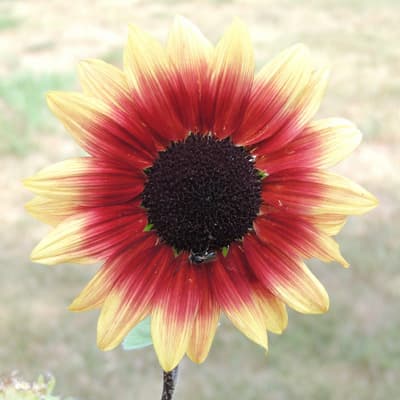
Varieties of Sunflowers
There are many types of sunflowers. And, gardeners like to grow a wide variety of them.
Sunflowers are basically separated by size. The giant varieties grow over ten feet. Regular sunflowers typically grow from six to ten feet. Miniatures are gaining in popularity as borders. They are very popular in Asia and grow two to four feet.
Some varieties of sunflowers have one big head or flower. They are usually the giant sunflower varieties. Other large-headed varieties have a few much smaller heads that form on lower branches. Some varieties have multiple heads. These are typically mid-sized sunflowers and are perfect for flower gardens in attracting birds.
Sunflower seeds are usually a dark brown to black, or large, grey and white striped. The latter is the most popular for eating due, to their large size. Don’t worry over selection. The birds will eat ample quantities of both, and so will you. Whether you are feeding the wildlife or not, there are plenty of wildlife that enjoy sunflowers. They include all sorts of birds, of course, squirrels, and rodents.
Giant Sunflowers – Many people find growing these to be addicting. A giant sunflower can be either a very tall plant, or an enormous flower head.
Tithonia, or Mexican Sunflower– Grow 4-6 feet tall, with daisy-like flowers. Blooms summer to fall.
Did you know? If you have a pet hamster, mouse, gerbil, or bird, add a few sunflower seeds to their diet, for a nice treat.
Sunflower Varieties – See the biggest and the best varieties around.
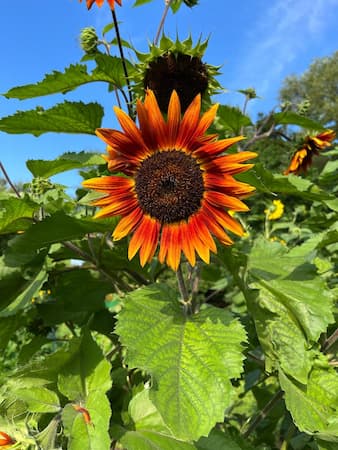
How to Start Sunflower Seeds
Sunflower seeds are best sown outdoors directly into the garden. After planting, cover them with a screen, as the birds and animals love to dig the seeds out. You can also start them in a seedbed and transfer them when they are small.
If you plant sunflowers indoors, use individual peat pots. Start two to three weeks before the last frost date for your area. Plant one or two seeds per pot, thinning to one before planting outdoors.
If you grow them to feed the birds, look for seedlings growing near the base of last year’s crop. They can be left to grow, or transplanted to another location.
Whether you plant directly outdoors or transplant them, make the final spacing as follows:
Giants: Space three feet apart in rows three to four feet apart.
Regular/Intermediate sizes: Space two feet apart in rows three feet apart.
Miniatures: Space one foot apart in rows three feet apart.
For individual planting, put the seedling or seeds in just about any sunny location. Plant either individual, in groups, or patterns. Make sure they are visible from your deck, porch, and windows.
Did you know? Sunflowers always point their blooms or face to the rising sun in the East. Keep this in mind as you determine where to plant them.
Tip: Miniatures make great borders or edging plants in flower gardens.
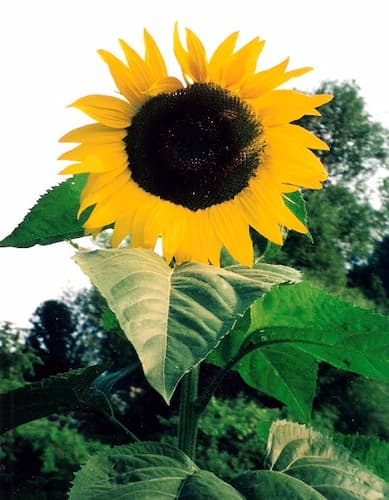
How to Grow Sunflowers
Sunflower plants grow well in average to rich soils. They need to grow their roots deep and wide, to enable them to withstand strong winds. If you have a choice, sandy soils are not recommended, as they are easily uprooted in loose soil. Rich soil is important, when growing giant varieties.
Contrary to it’s name, we found they will tolerate some shade as we put them against an east wall of our house every year. However, they will grow their best in full sun.
Deep roots help sunflowers to withstand most droughts. They will benefit from a dose of fertilizer when you apply it to the rest of your garden. Apply extra phosphorus and potassium when the flower bud begins to develop, to promote bigger blooms.
Tip: If you are crowded for space, plant one or two sunflowers amidst your vine crops. One or two will not seriously shade the vines. Make sure not to plant them near their tap roots for the vines.
If you are growing sunflowers in a windy area and have light, loose soil, you may want to stake taller varieties, to keep them from falling over.
Also See:
Soil Temperatures – Ideal germination temperature by vegetable
Ideal Soil pH – by vegetable
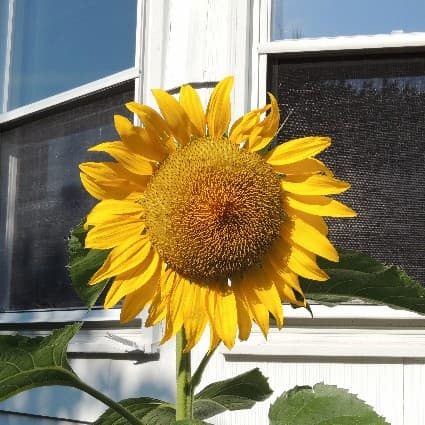
Harvesting Sunflowers
Days to Maturity: 70 to 90 days or more, depending upon the variety. Read the package for the specific time for the variety you acquire.
Harvest sunflower seeds after the flower begins to die back, and most if not all, of the petals, have fallen off. Pull out a seed and open it to see if it is full. Cut off the head, leaving a few inches of stalk. Hang the stalks to dry in a well-ventilated area. Do not stack them in a box, as mold can develop during the drying process. As soon as the flowers have dried, extract the seeds by rubbing two flower heads together. They should come off of the flower head fairly easily.
Sunflowers are also used as dried flowers in vases and for craft projects. They can be cut just before the flowers die off and dried over a few weeks. Miniature sunflowers make lovely fresh bouquets also. For craft projects, it is important to leave a sufficient amount of stalk.
We enjoy sharing this crop with wildlife. We also enjoy eating the seeds, too. Birds and squirrels will begin their assault before the seeds are completely ripe. You can protect against this annual invasion by covering the entire flower with an old nylon stocking, a cheesecloth bag, or any other covering that allows light and especially air to flow through. Do not use plastic bags, as moisture buildup will rot the flower, and heat buildup will scald it. Some people will put a bag below the flower to catch any seeds that fall.
Insects and Pests
The birds and squirrels are the primary invaders for your Sunflower crop.
Fortunately, most insects are not a problem. Occasionally, ants enjoy the nectar from the flower. They are no real threat to the seeds.
Plant Disease
Sunflowers seldom have disease problems. Score another point for an easy to grow and enjoyable plant!
Plant Problems – Diagnosis, causes, and cures for many common plant problems.
Plant Hardiness
All varieties of sunflower plants are annuals. They can withstand a mild frost. However, cover your seedlings, if a hard spring freeze is anticipated.
Related Articles
People who read this article also like:
Sunflower Gallery – free pictures for personal and non-profit use
Roasted Sunflower Seeds– from our cookbook
Roasted Sunflower Seeds are the rage. Try this recipe from Pumpkin Nook.
Please support our site. Shop for:
- rmmatthews100@hotmail.com
- 585-721-6528
- Rochester, NY
©1999-2024 GardenersNet.Com, All Rights Reserved

